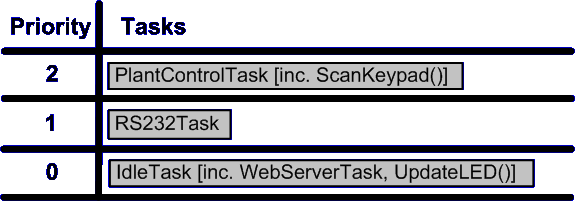|
|||||||||||||||
Solution #4
|
|||||||||||||||
 |
Creates only two application tasks so therefore uses much less RAM than solution #2. |
 |
The RTOS context switching overhead is reduced to a minimum - although more CPU cycles might be utilised by the idle task which can no longer make use of power saving modes. |
 |
Only a subset of the RTOS features are used. This necessitates a greater consideration of the timing and execution environment at the application source code level, but still allows for a greatly simplified design (when compared to solution #1). |
 |
Reliance on processor peripherals. Non portable. |
 |
The problems of analysis and interdependencies between modules as were identified with solution #1 are starting to become a consideration again - although to a much lesser extent. |
 |
The design might not scale if the application grows too large |
Conclusion
Features of the RTOS kernel can be used with very little overhead, enabling a simplified design even on systems where processor and memory constraints prevent a fully preemptive solution.
Example
This example is a partial implementation of the hypothetical application introduced previously. The FreeRTOS API is used.
High Priority Task
The high priority task is triggered by a semaphore 'given' by a periodic interrupt service routine:
void vTimerInterrupt( void )
{
// 'Give' the semaphore. This will wake the high priority task.
xSemaphoreGiveFromISR( xTimingSemaphore );
// The high priority task will now be able to execute but as
// the cooperative scheduler is being used it will not start
// to execute until we explicitly cause a context switch.
taskYIELD();
}
Note that the syntax used to force a context switch from within an ISR is different for different ports.
Do not copy this example directly but instead check the documentation for the port you are using.
The high priority task contains both the plant control and keypad functionality. PlantControlCycle() is called first
to ensure consistency in its timing.
void HighPriorityTaskTask( void *pvParameters )
{
// Start by obtaining the semaphore.
xSemaphoreTake( xSemaphore, DONT_BLOCK );
for( ;; )
{
// Another call to take the semaphore will now fail until
// the timer interrupt has called xSemaphoreGiveFromISR().
// We use a very long block time as the timing is controlled
// by the frequency of the timer.
if( xSemaphoreTake( xSemaphore, VERY_LONG_TIME ) == pdTRUE )
{
// We unblocked because the semaphore became available.
// It must be time to execute the control algorithm.
PlantControlCycle();
// Followed by the keyscan.
if( KeyPressed( &Key ) )
{
UpdateDisplay( Key );
}
}
// Now we go back and block again until the next timer interrupt.
}
}
RS232 Task
The RS232 task simply blocks on a queue waiting for data to arrive. The RS232 interrupt service routine must post the data onto the queue - making the task ready to run - then force a context switch. This mechanism is as per the timer interrupt pseudo code given above.
The RS232 task can therefore be represented by the following pseudo code:
void vRS232Task( void *pvParameters )
{
DataType Data;
for( ;; )
{
if( cQueueReceive( xRS232Queue, &Data, MAX_DELAY ) )
{
ProcessRS232Data( Data );
}
}
}
The Embedded Web Server and LED Functionality
The remaining system functionality is placed within the idle task hook. This is simply a function that is called by each cycle of the idle task.
void IdleTaskHook( void )
{
static TickType_t LastFlashTime = 0;
ProcessHTTPRequests();
// Check the tick count value to see if it is time to flash the LED
// again.
if( ( xTaskGetTickCount() - LastFlashTime ) > FLASH_RATE )
{
UpdateLED();
// Remember the time now so we know when the next flash is due.
LastFlashTime = xTaskGetTickCount();
}
}
NXP tweet showing LPC5500 (ARMv8-M Cortex-M33) running FreeRTOS.
Meet Richard Barry and learn about running FreeRTOS on RISC-V at FOSDEM 2019
Version 10.1.1 of the FreeRTOS kernel is available for immediate download. MIT licensed.
View a recording of the "OTA Update Security and Reliability" webinar, presented by TI and AWS.
FreeRTOS and other embedded software careers at AWS.














